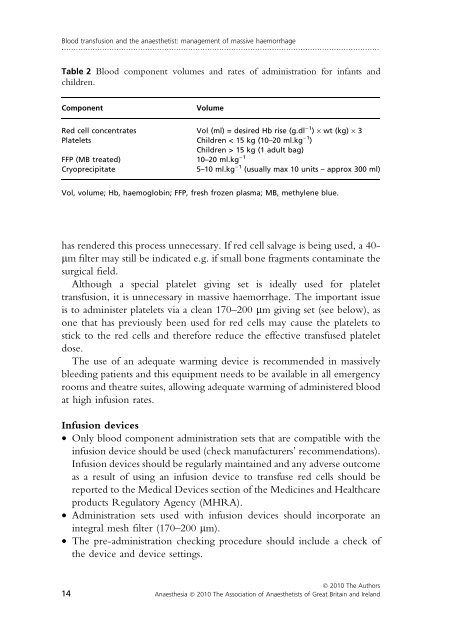Blood transfusion and the anaesthetist: management of ... - aagbi
Blood transfusion and the anaesthetist: management of ... - aagbi
Blood transfusion and the anaesthetist: management of ... - aagbi
Create successful ePaper yourself
Turn your PDF publications into a flip-book with our unique Google optimized e-Paper software.
<strong>Blood</strong> <strong>transfusion</strong> <strong>and</strong> <strong>the</strong> anaes<strong>the</strong>tist: <strong>management</strong> <strong>of</strong> massive haemorrhage<br />
.....................................................................................................................................<br />
Table 2 <strong>Blood</strong> component volumes <strong>and</strong> rates <strong>of</strong> administration for infants <strong>and</strong><br />
children.<br />
Component Volume<br />
Red cell concentrates Vol (ml) = desired Hb rise (g.dl )1 ) · wt (kg) · 3<br />
Platelets Children < 15 kg (10–20 ml.kg )1 )<br />
Children > 15 kg (1 adult bag)<br />
FFP (MB treated) 10–20 ml.kg )1<br />
Cryoprecipitate 5–10 ml.kg )1 (usually max 10 units – approx 300 ml)<br />
Vol, volume; Hb, haemoglobin; FFP, fresh frozen plasma; MB, methylene blue.<br />
has rendered this process unnecessary. If red cell salvage is being used, a 40lm<br />
filter may still be indicated e.g. if small bone fragments contaminate <strong>the</strong><br />
surgical field.<br />
Although a special platelet giving set is ideally used for platelet<br />
<strong>transfusion</strong>, it is unnecessary in massive haemorrhage. The important issue<br />
is to administer platelets via a clean 170–200 lm giving set (see below), as<br />
one that has previously been used for red cells may cause <strong>the</strong> platelets to<br />
stick to <strong>the</strong> red cells <strong>and</strong> <strong>the</strong>refore reduce <strong>the</strong> effective transfused platelet<br />
dose.<br />
The use <strong>of</strong> an adequate warming device is recommended in massively<br />
bleeding patients <strong>and</strong> this equipment needs to be available in all emergency<br />
rooms <strong>and</strong> <strong>the</strong>atre suites, allowing adequate warming <strong>of</strong> administered blood<br />
at high infusion rates.<br />
Infusion devices<br />
• Only blood component administration sets that are compatible with <strong>the</strong><br />
infusion device should be used (check manufacturers’ recommendations).<br />
Infusion devices should be regularly maintained <strong>and</strong> any adverse outcome<br />
as a result <strong>of</strong> using an infusion device to transfuse red cells should be<br />
reported to <strong>the</strong> Medical Devices section <strong>of</strong> <strong>the</strong> Medicines <strong>and</strong> Healthcare<br />
products Regulatory Agency (MHRA).<br />
• Administration sets used with infusion devices should incorporate an<br />
integral mesh filter (170–200 lm).<br />
• The pre-administration checking procedure should include a check <strong>of</strong><br />
<strong>the</strong> device <strong>and</strong> device settings.<br />
Ó 2010 The Authors<br />
14 Anaes<strong>the</strong>sia Ó 2010 The Association <strong>of</strong> Anaes<strong>the</strong>tists <strong>of</strong> Great Britain <strong>and</strong> Irel<strong>and</strong>

















